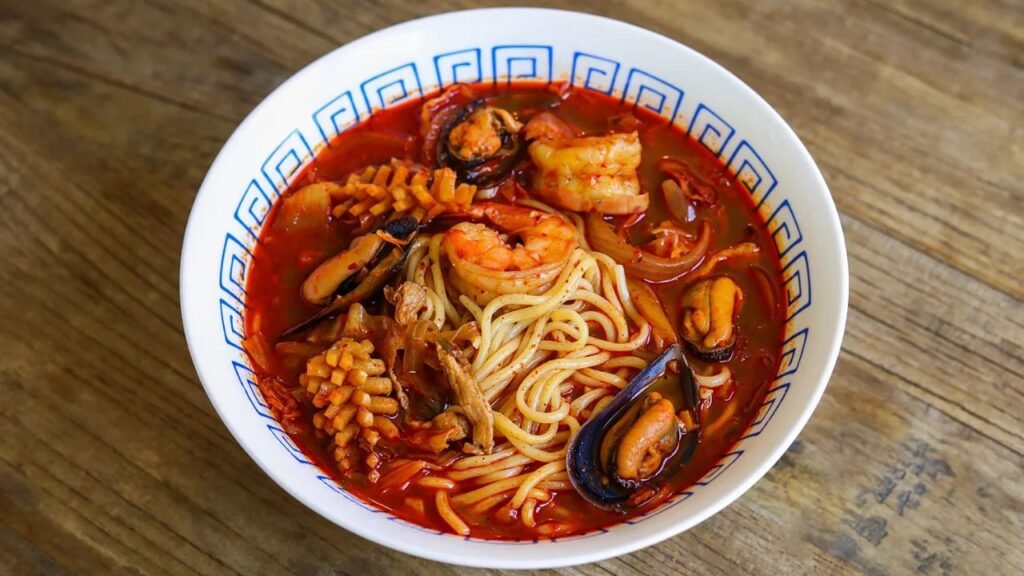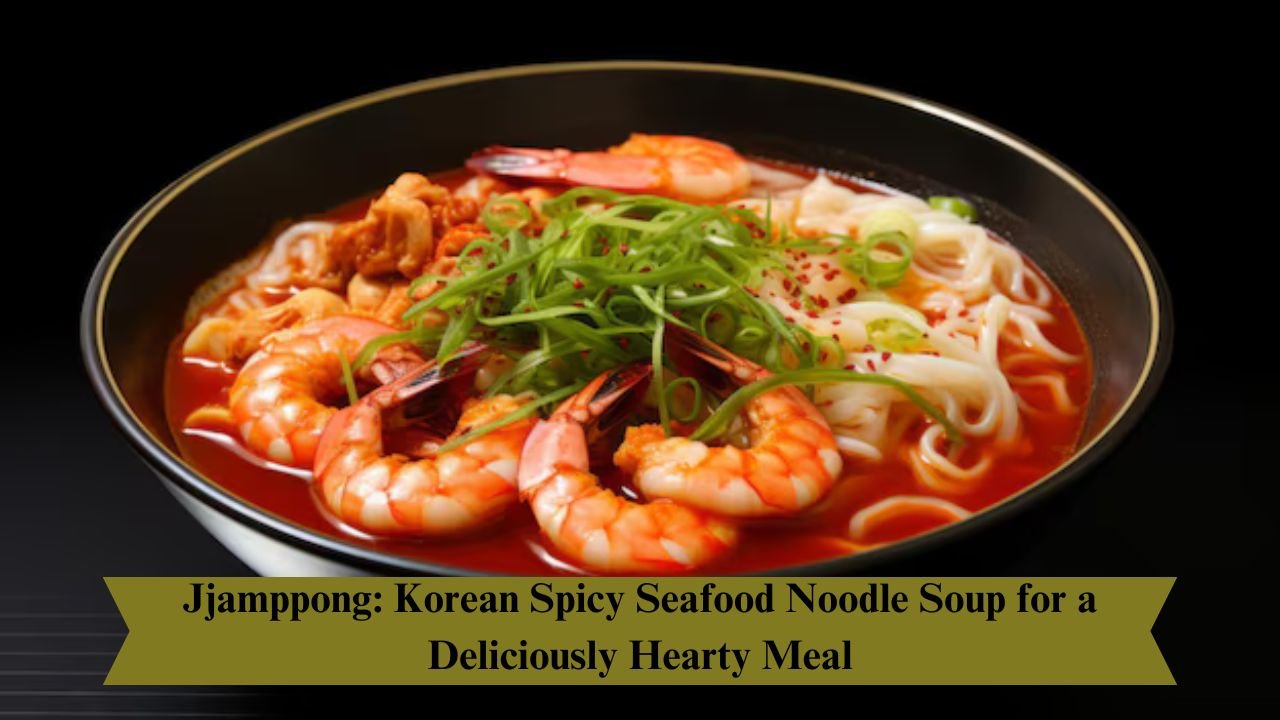INTRODUCTION
A dish that most Koreans love is called jjampong-it is a seafood noodle soup that is more piquantly flavored and spicy. The strong flavor and richly colored ingredients used in its preparation have made it become popular not only in Korea but also in other countries. Dinner or a sitdown meal with friends and loved ones will surely be fantastic with this mouthwatering soup.
This article will describe the history of jjampong, it will talk about the ingredients to make it, and give a recipe that will guide you in preparing this mouthwatering dish at home. You will learn how to enjoy jjampong in your own kitchen-from delicious to be fun to make as well. Whether you make it for a simple dinner or present it to your guests on a special occasion, this soup always goes down well.

Now, let us step into the wonderful world of Jjampong and learn how to make it so that you too can taste this exciting and delicious experience with your family and friends.
What is Jjamppong?
Jampong is one of the newest dishes to hit the tables of Korean homes and Chinese restaurants. This dish is traditionally made with a hot broth using gochugaru, Korean red chili powder. This soup contains a variety of seafood, making it a nutrition-rich dish.
The special characteristic of jjampong is in the junction of the different flavors and textures, particularly during cool months. It happens to be a highly delicious and fulfilling option for lunch or dinner. The bowl of hot soup warms the body and causes the entire experience of consumption to be extremely pleasurable.
This dish is effortless to enjoy and fun to prepare. Regardless of whether you share it with your family or enjoy it all to yourself, Jjampong will give you one unforgettable experience each time. Why not add this unbelievable soup to your next meal and taste the deliciousness?
Origins of Jjamppong

It is generally believed that the dish named “zjampong” originated from Chinese cuisine under the name “zhajiangmian”. Over time, it has become a food that is distinctly Korean and has a wonderful blend of regional flavors and ingredients.
Jjampong, commonly served in Chinese-Korean restaurants, has become a permanent dish in Korean homes. Every family has its own unique way of making jjampong, which makes this dish even more special.
Each family prepares it in its own way, resulting in a rich experience of different tastes and textures. Be it a traditional recipe or a new take, Jjampong has always been a favorite dish. This dish is not only delicious to eat, but it is also fun to prepare. Thus, Jjampong’s journey from Chinese cuisine to Korean kitchen is an interesting story, allowing us to experience cultural diversity.
Jjamppong Variations
There are numerous variations of jjampong in Korea, and many of them do not include spicy elements. The soup we are going to describe today is a “hot seafood noodle soup,” commonly just called “Haemul Jjampong” (해물 짬뽕).
It can also be served without noodles if one does not like the eating of noodles. It can be served together with steamed rice. It will then be called “jjampong bap” (짬뽕밥).
It is great and perfect for your comforting meal, especially if it’s light and easy to digest. The mixture of rice with the amazing taste of seafood gives it a unique experience. Whether you like it with noodles or rice, Jjampong is always delicious. The special thing about this dish is that it can be prepared according to everyone’s taste.

Ingredients
Main
- 50 g / 1.8 ounces zucchini, thinly sliced
- 2 shiitake mushrooms (50 g / 1.8 ounces), cleaned, stems removed and thinly sliced
- 120 g / 4.3 ounces cabbage, thinly shredded
- 35 g brown onion, thinly sliced
- 6 mussels (200 g / 7 ounces) or more, cleaned
- 6 littleneck clams or more, cleaned
- 6 large prawns (140 g / 5 ounces) or more, head & shells removed and tail left on, cleaned
- 6 squid rings or baby octopus or more
- 450 g / 16 ounces fresh Korean chinese style noodles (or thin udon noodles or ramen noodles)
- 20 g / 0.7 ounces baby spinach or baby bok choy
Chili Oil Seasoning
- 3 Tbsp Korean chili oil or neutral cooking oil
- 3 Tbsp Korean chili flakes (gochugaru), can be adjusted to your preferred spice level
- 1 tsp minced garlic
- 1 tsp minced ginger
- 20 g / 0.7 ounces green onion – white part
Soup Base
- 1 Tbsp rice wine
- 2 Tbsp soy sauce, regular
- 4 & 3/4 cups homemade Korean soup stock or water
- 1/4 tsp fine sea salt, can be adjusted to your taste
- A few sprinkles of ground black pepper
Instructions
- Heat a wok (or large deep pot) over low heat until hot. Now add oil, Korean chili powder, minced garlic, ginger and green onion.
- Keep stirring continuously for one to two minutes so that everything gets mixed well. Take care that the chilli paste does not burn, as this can spoil the taste.
- When the pot reaches medium temperature, add the zucchini, mushrooms, cabbage, and onion.
- Cook for one to two minutes, until they become slightly wilted. Next, add the oysters, littleneck clams, prawns and squid (or baby octopus) and stir to combine.
- Add rice wine, soy sauce, and Korean soup stock (or water). Increase the temperature to medium-high. Cover the soup and let it simmer.
- Continue cooking for about eight minutes, making sure not to overcook the ingredients.
- After removing the lid, add salt and some ground black pepper. Also add baby spinach just before serving. Baby bok choy may take a little longer to cook.
- While the soup is boiling (in step 3), cook the noodles in boiling water according to the directions on the soup.
- After cooking, filter the noodles and then wash them for some time in cold water. It is advisable to finish Steps 3 and 4 at approximately the same time.
- Now distribute all the noodles, seafood and soup evenly among the three soup bowls. Serve as quickly as possible.
- If you don’t want to serve the soup with noodles, you can also serve it with steamed rice.
Health Benefits of Jjamppong
Jhampong is not only delicious but also nutritious. The meal is a well-balanced meal because it’s rich in nutrients, such as carbs from the noodles, fiber through vegetables and protein through seafood
Seafood is rich in omega-3 fatty acids, which are very beneficial for good health. The complex mix of vegetables further avails all the required vitamins and minerals in order to have health in overall system.
Thus, jzhampong offers excellent taste to your mouth and further provides you with much-needed nutrients, so it is an excellent deal. By serving it to your belly, besides delighting your taste buds, you are actually nourishing the human body.

Tips for the Best Jjamppong
- Fresh Seafood: Your Jzhampong will be even tastier if you use fresh fish. For this, if possible, go to a local seafood market and buy the best fish.
- You can also add any amount of extra veggies you prefer: more spinach, mushrooms, or peanut sprouts.
- Make it less spicy: If you prefer a not-so-hot soup, reduce the amount of gochugaru (Korean red pepper flakes) or omit it altogether.
- Noodle Choice: Although wheat noodles are the traditional choice, you can also use udon or even instant ramen noodles if you are in a hurry.
- Additions: And don’t forget garnishing it before presentation – using chopped capsicum, mushrooms or boiled eggs gives that extra flavor.
And that’s the beauty of the jzhampong as I would like to think-it’s personalized according to one’s preference, making it all the more special. Freshness, you see, with colors of vegetables, will do the job and make your meals superb.
Serving Suggestions
Jzhampong is best served hot and fresh. A complete meal would include having kimchi or banchan, which are Korean side dishes.
Makgeolli is a rice wine from Korea that can serve as a cooling agent to counteract the spiciness of the soup.
Thus, combining kimchi and makgeolli with jjampong not only makes your meal even tastier, but it also makes your experience more special. When you enjoy these things with jjampong, it provides a complete Korean dining experience. Hot soup, spicy kimchi, and cold makgeolli—all together create a wonderful taste and satisfying experience.

CONCLUSION
Jzhampong is a very savory and satisfying dish, the delicious taste and richness from seafood coupled with spicy broth. The dish is perfect for any occasion, and there’s an opportunity to experience in the comfort of one’s home the warmth of Korean food in your own kitchen.
Jzhampong is not only known for its wonderful taste and attractive colours, but it is also sure to leave a deep impression on your family and friends. Gather all the ingredients, and then have fun making this delicious seafood noodle soup that has a special twist of spicy flavor!
While you cook this delectable dish, you will experience something out of Korea. The preparation process of jzhampong is very creative and fun. Sharing it with loved ones can make it a memorable meal.
FAQ’s
Korean Jjamppong: Healthy?
Jjamppong is extremely popular because this meal is healthy as well as filling.
Is jjampong spicy?
Spicy, savory soup.
Chinese or Korean dish: jjampong
Jjampong is a very popular Chinese-style Korean.

